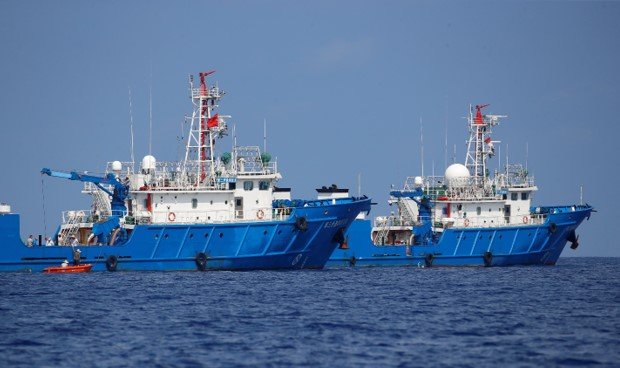Military tensions in the South China Sea escalated on Saturday with a new round of exercises by rival superpowers, as joint drills led by the United States and its allies coincided with Chinese military maneuvers in the contested waters. The region, which is vital for global trade and rich in resources, has long been a flashpoint for territorial disputes, and the latest round of drills reflects the heightened strategic competition between Beijing and Washington.
Joint Drills by U.S. and Allies
On Saturday (September 28) , the U.S. conducted the fourth Multilateral Maritime Cooperative Activity in the Philippines’ exclusive economic zone (EEZ) with military forces from Australia, Japan, New Zealand, and the Philippines. The exercises, aimed at reinforcing freedom of navigation and adherence to international law, are part of a broader U.S. strategy to strengthen military ties in the region and push back against China’s growing assertiveness in the South China Sea.
A significant moment in the drills was Japan’s Maritime Self-Defense Force transiting the Taiwan Strait en route to join the exercises, a move that drew an immediate rebuke from Beijing. China, which considers Taiwan a core national interest, lodged a formal protest with Japan on Thursday, accusing Tokyo of crossing a “red line.” The joint military activity highlights the increasing alignment between U.S. allies in the region in the face of China’s territorial ambitions.
The U.S. Indo-Pacific Command said the exercises demonstrated “the right to freedom of navigation and overflight” and the commitment to upholding international maritime rights. “The U.S. and our partners will continue to work together to ensure peace and stability in the region,” the command said in a statement.
China’s Military Maneuvers
Meanwhile, China’s People’s Liberation Army (PLA) launched its own military drills on Saturday, focused on reconnaissance and patrols around the Scarborough Shoal, an area located within the Philippines’ EEZ and a focal point of overlapping territorial claims. The PLA’s Southern Theatre Command said in a statement that its forces were conducting “routine” patrols aimed at safeguarding China’s “sovereignty, security, and maritime rights.”
The timing of the Chinese drills comes shortly after talks between Chinese Foreign Minister Wang Yi and U.S. Secretary of State Antony Blinken in New York earlier this week. Although both sides discussed ways to reduce tensions in the South China Sea, military activities have continued unabated. China’s sweeping maritime claims, which cover almost the entire South China Sea, were rejected by the Permanent Court of Arbitration in 2016. However, Beijing has refused to recognize the ruling and continues to assert control over key maritime features, including Scarborough Shoal. This disregard for international law complicates efforts to peacefully resolve the ongoing disputes.
Flashpoints and Rising Tensions
The recent surge in military activity follows months of rising tensions between China and the Philippines over disputed territories. In July, a resupply mission to the Philippine outpost on the Second Thomas Shoal triggered confrontation with Chinese vessels. Manila has since lodged multiple diplomatic protests over Chinese actions in the region, including the August deployment of flares by Chinese aircraft near a Philippine patrol plane over Scarborough Shoal.
On Saturday, Manila reaffirmed its defense cooperation with the U.S. and its regional partners. “These exercises are a testament to our strong security ties with our allies and our shared commitment to upholding the rule of law,” a spokesperson for the Philippine armed forces said.
Despite these confrontations, China has continued to monitor resupply missions to the Sierra Madre, a dilapidated Philippine naval ship stationed at Second Thomas Shoal to assert its territorial claims. China’s actions underscore its resolve to maintain a presence in contested waters while resisting efforts to challenge its expansive claims.
Diplomatic Efforts and Military Build-up
Recent diplomatic talks, including the meeting between Wang Yi and Antony Blinken, have so far done little to ease tensions. While Blinken raised concerns about China’s “dangerous and destabilizing actions” in the South China Sea, China accused the U.S. of provoking regional instability by conducting military exercises with its allies.
“The U.S. should refrain from stirring up trouble in the South China Sea,” Wang Yi said in a statement following the talks. The Chinese Foreign Ministry emphasized that differences should be resolved through dialogue with the countries directly concerned, not through external interference.
According to a report by a Beijing-based think tank, foreign warships spend more than 20,000 days annually in the South China Sea, with U.S. Navy ships accounting for about 1,600 of those days. This sustained military presence by various nations adds to the complexity of the security situation in the region, where multiple countries, including Brunei, Malaysia, Vietnam, and the Philippines, have competing territorial claims.
The surge in military drills in the South China Sea reflects the growing divide between China and the U.S. and its allies over the future of one of the world’s most strategically important waterways. As tensions rise, both sides continue to bolster their military presence, with diplomacy taking a back seat to displays of power.


